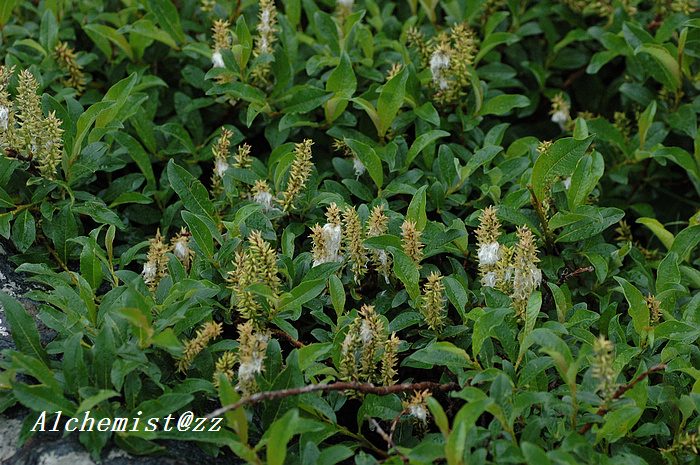- Scientific Name: Salix nummularia Andersson
- Ref: DC., Prodr. 16(2):298. 1868
- Synonyms: Salix nummularia subsp. tundricola (Schljakov) Á.Löve & D.Löve, S. pauciflora Koidz., S. polyadenia Hand.-Mazz., S. tschanbaischanica Y.L.Chou & Y.L.Chang, S. tundricola Schljakov, S. vulcani Nakai
- English Common Name: coinleaf willow
- Chinese Common Name: 多腺柳 duōxiàn∙liǔ, 长白柳 Chángbái liǔ
- Japanese Common Name: エゾマメヤナギ [蝦夷豆柳] ezomameyanagi
- Family: Salicaceae
- Genus: Salix
- Distribution: Alpine tundra; 2200-2600 m. Jilin (Changbai Shan) [Russia].
- Photo: Mt. Changbai, Jilin
Shrubs procumbent, dwarf; bark russet. Branches to 80 cm, (2-)10 mm thick; branchlets yellowish brown, pilose when young, glabrescent. Buds oblong-ovoid, 2-3 mm, glabrous. Stipules present; petiole ca. 3 mm, pilose when young, glabrescent; leaf blade obovate-elliptic, suborbicular, or elliptic, 0.5-1.7 × 0.5-1.5 cm, leathery, abaxially green, villous when young, glabrescent, adaxially dull green, base rounded or rounded-cuneate, margin entire, apex rounded, obtuse, or retuse. Flowering coetaneous. Catkins terminal. Male catkin ovoid, ca. 8 mm, 10-20-flowered; bracts yellowish brown, orbicular, ca. 1 mm, long pubescent. Male flower: glands 2, 0.3-0.4 mm, adaxial gland ovate or orbicular, sometimes 2-cleft, abaxial gland 2- or 3-parted or entire; stamens 2, distinct, glabrous. Female catkin 5-8 mm, 10-20-flowered; bracts as in male catkin. Female flower: adaxial gland usually 2- or 3(or 4)-lobed, ca. 2 × as long as stipe, abaxial gland shorter than adaxial gland; ovary sublanceolate, apex acuminate, 3-4 mm, glabrous; stipe ca. 1 mm, elongated in fruit; style ca. 0.5 mm; stigma 4-lobed. Fl. Jul, fr. Jul. (Flora of China)
